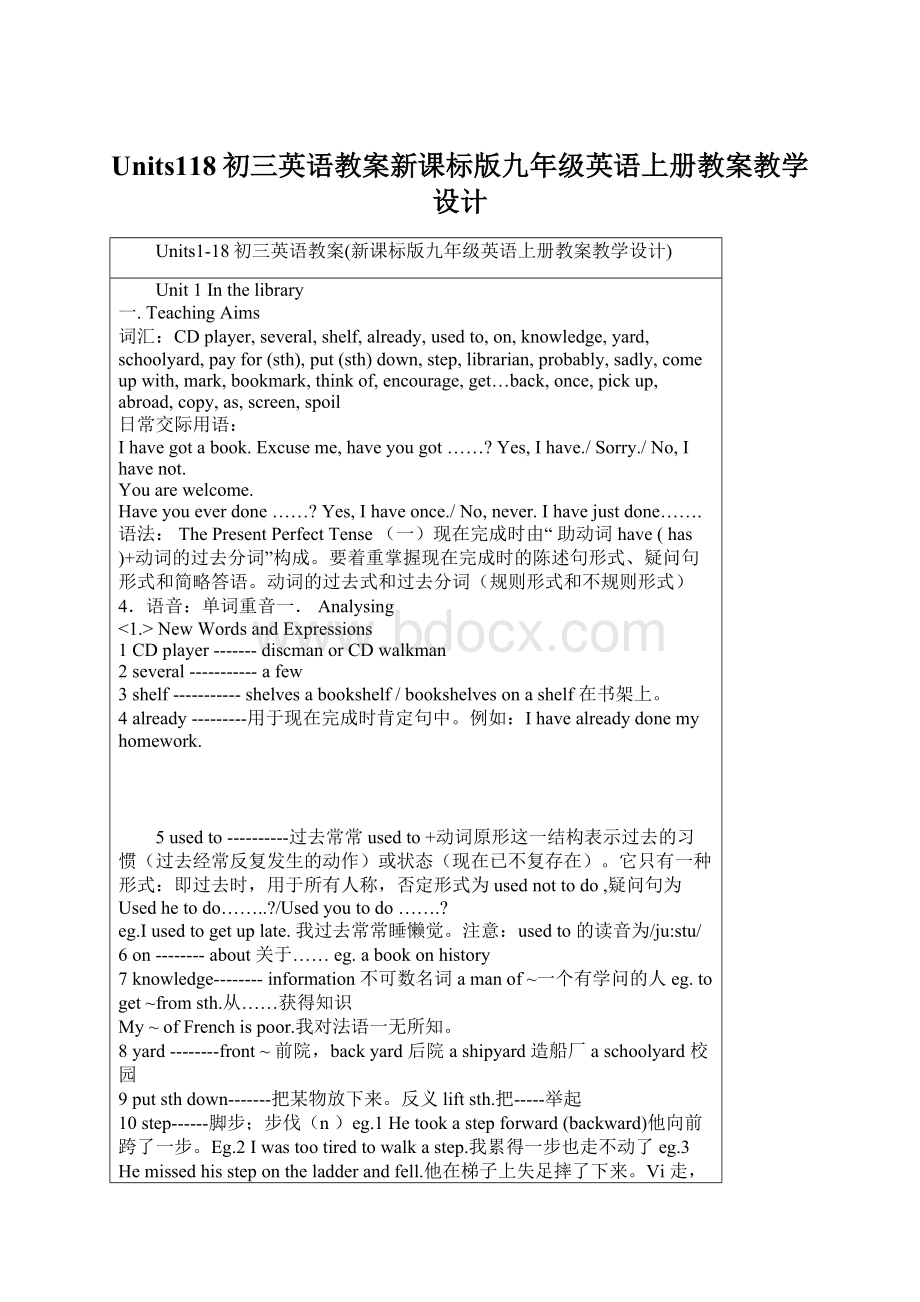Units118初三英语教案新课标版九年级英语上册教案教学设计.docx
《Units118初三英语教案新课标版九年级英语上册教案教学设计.docx》由会员分享,可在线阅读,更多相关《Units118初三英语教案新课标版九年级英语上册教案教学设计.docx(48页珍藏版)》请在冰豆网上搜索。

Units118初三英语教案新课标版九年级英语上册教案教学设计
Units1-18初三英语教案(新课标版九年级英语上册教案教学设计)
Unit1Inthelibrary
一.TeachingAims
词汇:
CDplayer,several,shelf,already,usedto,on,knowledge,yard,schoolyard,payfor(sth),put(sth)down,step,librarian,probably,sadly,comeupwith,mark,bookmark,thinkof,encourage,get…back,once,pickup,abroad,copy,as,screen,spoil
日常交际用语:
Ihavegotabook.Excuseme,haveyougot……?
Yes,Ihave./Sorry./No,Ihavenot.
Youarewelcome.
Haveyoueverdone……?
Yes,Ihaveonce./No,never.Ihavejustdone…….
语法:
ThePresentPerfectTense
(一)现在完成时由“助动词have(has)+动词的过去分词”构成。
要着重掌握现在完成时的陈述句形式、疑问句形式和简略答语。
动词的过去式和过去分词(规则形式和不规则形式)
4.语音:
单词重音一.Analysing
<1.>NewWordsandExpressions
1CDplayer-------discmanorCDwalkman
2several-----------afew
3shelf-----------shelvesabookshelf/bookshelvesonashelf在书架上。
4already---------用于现在完成时肯定句中。
例如:
Ihavealreadydonemyhomework.
5usedto----------过去常常usedto+动词原形这一结构表示过去的习惯(过去经常反复发生的动作)或状态(现在已不复存在)。
它只有一种形式:
即过去时,用于所有人称,否定形式为usednottodo,疑问句为Usedhetodo……..?
/Usedyoutodo…….?
eg.Iusedtogetuplate.我过去常常睡懒觉。
注意:
usedto的读音为/ju:
stu/
6on--------about关于……eg.abookonhistory
7knowledge--------information不可数名词amanof~一个有学问的人eg.toget~fromsth.从……获得知识
My~ofFrenchispoor.我对法语一无所知。
8yard--------front~前院,backyard后院ashipyard造船厂aschoolyard校园
9putsthdown-------把某物放下来。
反义liftsth.把-----举起
10step------脚步;步伐(n)eg.1Hetookastepforward(backward)他向前跨了一步。
Eg.2Iwastootiredtowalkastep.我累得一步也走不动了eg.3Hemissedhisstepontheladderandfell.他在梯子上失足摔了下来。
Vi走,踏入,踩Hesteppedintotheroom.他走进房间。
11librarian--------apersonwhosejobistohelpinthelibrary.
12probably-------maybe,perhaps
13pay------to~sbforsth.payforsth(paid,paid)eg.Ipaidtenyuanforthebook.我花了十元买了这本书。
14sadly------adv.sad+ly,happy---happily
15comeupwith-------tofindtheanswertosth.
16mark------amarkonthewall墙上的记号bookmark书签Thebookmarkisverynice.
17thinkof-------想到,认为,{tothinkofsth(sb)/tothinkaboutsth.}eg.WhenIlookatthephoto,Ialwaysthinkofmymother.
18encourage-----1.to~sbtodosth.2.to~sbwithsth.Eg.Theteacher~edmetogoabroad.
19get….back-------return取回,归还
20pickup-------to~sthfrom……../topicksthupfrom…..
21once------一次(表示次数)twice(两次)threetimesfourtimesetc.
22abroad-------togo~,be~,tostudy~.去国外学习。
23copy-------to~sth.复制,拷贝To~one’sexample,重蹈某人的覆辙。
24as----prep(介词)作为eg.Asastudent,weshouldstudyhardallkindsofsubjects.作为一名学生,我们应该努力学好各门功课。
25screen-----n.屏幕afilm~,aTV~
26spoil-----to~sth.Eg.Don’t~yourbook.Takecareofit.别糟蹋了书,要爱护书。
<2>Languagepointsoftheunit本单元语言点
Lesson1
1.Haveyougot…….?
你有…..吗?
havegot=haveeg.Haveyougotanybrothersandsisters?
=Doyouhaveany……?
I’vegotacellphone.我有一个手机。
Lesson2
1.Sheusedtobeahistoryteacher.她过去是一位历史老师。
“usedto+动词原形”这一结构表示过去的习惯,过去经常反复发生的动作或状态(现在已不复存在),它只有一种形式即“过去式”用于所有人称。
否定式为“usednotto”疑问式为“Usedyouto……..?
eg.Iusedtogetuplateinthemorning.
2.Herhobbyisreading.她的爱好是读书。
reading是一个动名词,在句中作表语。
此句也可改成“Readingisherhobby.”类似的句子还有“Myworkiscleaning.我的工作是打扫卫生。
WhatIlikebestisfishing.我最大的爱好是钓鱼。
3.Shelikesreadingonmanydifferentsubjects.她喜欢读许多方面的书籍。
likedoingsth/liketodosth的区别likedoingsth表示“喜欢做经常性的动作”而liketodosth则表示喜欢做更具体的某一事情。
另外,此句中的“on”和“about”的意思相近,是“有关”或“关于”的意思,on一般较正式。
eg.Hereisabookonhistory.这儿有一本关于历史的书。
4.Theygivemeknowledgeandmakemehappy.它们给我知识并使我快乐。
此句中的they是指的books,句中的happy是宾语补足语。
5.Shesometimesreadsafewlines,putsdownthebook,walksafewstepsandthinksforawhileandthenwalksawaywiththebook.有时,她读上几行,放下书,走几步,思考一会儿,然后拿着书走开了。
line=wordsthatarebesideeachotheronapage(字的行)eg.Ireadafewlinesofit,butIcouldn’tunderstandawordofit.我读了几行,但一个字也不懂。
6.……..whensheleftforhome,….当她启程回家时,leavefor…..意为离开…..去…..eg.MaryleftforShanghaiyesterday.玛丽昨天启程去上海。
7.Whatwasworse,…..更为糟糕的是,…..eg.Ilostmypen,whatwasworse,Ididn’thaveanymoneytobuyatickethome.我丢了钢笔,更糟糕的是,我没钱买回家的票。
8.I’mafraidI’llhavetopayforthelostbooks.恐怕我得赔偿丢失的书了。
9.Onedaythelibrariancameupwithanidea.一天,图书馆管理员想出了一个主意。
comeupwith=tothinkout/thinkof(aplan,idea,answer);produceeg.Hecouldn’tcomeupwithananswerwhenIaskedhimwhyhewaslate.当我问他为什么迟到时,他无言对答。
Lesson4“Chicken,Run”《小鸡,快跑》见教科书P200注释。
Sometranslations:
1.我在学校书店买了这本书。
2.你看见我的历史书了吗?
我刚才放在这儿的。
3.我五分钟前看见老师在办公室的,现在肯定还在那儿。
4.李磊以前经常上课迟到。
5.林涛的奶奶喜欢看不同题材的小说书。
6.读书能给我们提供知识,使我们愉快。
7.我和我父母亲每天傍晚在校园里散步。
8.我的自行车坏了,更糟糕的是校车也已经开走了。
9.王老师鼓励我们多做数学练习和英语练习。
10.最后,二班的学生们终于找到了解决问题的办法。
三.TeachingSteps
Lesson1
Step1.Revision
1.WelcometheSsbysaying“Welcomebacktoschool.
2.Review“thepasttense”byaskingtheSstoworkinpairs.Tellthemtoaskabout“Whatdidheorshedointhesummerholidays?
3.Review“Doyouhave……?
”byaskingaboutschoolthingslikepen,pencil,eraser,ruler,etc.Usepluralformsaswell.AsktheSstopractisetheuseof“some”and“any”
Step2Presentation
TelltheSs“Now,wearegoingtolearnanotherwayofsaying“Doyouhave…..?
”Listencarefully.Haveyougotapencil?
Yes,I’vegotone.”Explainthat“I’vegot=Ihavegotand“one”means“apencil”.Itrefersanobjectyoumentionedjustnow.Givethemodelagain.Sslistenandrepeat.Askandansweraboutotherobjects.
Step3Readandact
SBP1Part1PractisethedialogueswiththewholeclassthenlettheSsworkinpairs.Askthemtomakeuptheirowndialoguestoactout.
DoWBLesson1Ex1inpairs.
Step4Practice
SBP1Part2ReadthroughthedialoguefortheSstolistenandrepeat.ThenlettheSsrole-playthedialogue.onestudentbeingthelibrarianandtheotherbeinglookingforabook.TellthemthattheycanaddotherwordsbesidesWhat’sinthebox.
DoWBLesson1Ex2.
Step5Presentation
Write“Haveyougotabook?
”obtheBb.PointouttheformofthePresentPerfectTense(have/has+pp).Explainthateveryverbhasapastparticipleform,ifaverbisaregularone,it’sthesameasthepastform,butifaverbisn’taregularone,ithasirregularform.(seeP255)Thistenseisusedtoindicateanactionthathappenedinthepastorjustamomentagowhentheresultingstateisstillpresent.Theteachercandropapenonthefloor,say“I’vedroppedmypen.Youcanseethepenonthefloor.”Openthedoor.Say“I’veopenedthedoor.Nowthedoorisopen.”etc.
Step6Readandact
SBP1Part3I’velostmysciencebook.Haveyouseenit?
Hehasfoundthebook.Underline“lost,seen,found”TheyarethePPoftheverbs:
lose,seeandfind.TelltheSstoreadthedialoguessilently.Ask2SstoactoutthedialogueAinP3.PlaythetapefortheSstolistenandrepeat.ThentheSspracticetheminpairs.GettheSstoactoutthedialogues.
Step7WB
WBLesson1Ex.3donetogetherinclass.Ex.4asoneofthehomework
Homework:
1.LearntheverbformsinEx.3
2.DoEx2intheexercisebooks.
3.RevisethedialoguesoftheLesson.
Lesson2TeachingSteps
Step1Revision
1.CheckthehomeworkandrevisethePresentPerfectTensebyaskingeachotherusing“Haveyougot…….?
”
2.RevisethedialoguesinSB.P1Part3
Step2Pre-reading
HavetheSsdiscusstheQsinpairs.Thenask“Whatkindsofbooksdoyouliketoread?
”SeehowmanySslikereadingEnglishbooks,historybooksetc.
Step3Reading
SBPage2Part2Lesson2.Booksclosed!
TelltheSstolistentothemainideaofthestory.(Grandmakeepslosinglibrarybooks)Booksopen!
PlaythetapeagainandhavetheSsreadwhiletheylisten.Teachthenewwordsandphrasesofthestory.(already,usedto,on,knowledge,yard,schoolyard,putdown,step,librarian,pay,payfor,sadly,comeupwith,bookmark
DoWBLesson2Ex1.
Step4Practice
Readingisonekindofhobby.Whatotherkindsofthingsarehobbies?
AsktheSstospeakouttheiranswersExamples:
hiking,biking,painting,traveling,swimming,collectingstamps,collectingcoinsetc.GettheSstotelleachothertheirownhobbies.
Step5WB
WBLesson2Exx2and3.Workinpairs.AskthemtofindoutsthinterestinginEx2.
Look—looked—looked(ABB)let—let—let(AAA)take—took—taken(ABC)run—ran—run(ABA)
Homework
1.WritedownEx2inexercisebooks.
2.Revisethestoryandtrytoretellit.
Lesson3TeachingSteps
Step1Revision
1.Astudentonduty
2.GettheSstoretellthestorybyaskingQs:
”Whoisthestoryabout?
Whatdoessheoftengotothelibraryfor?
”etc.
Step2Reading
SB.P3.Part1.Lesson3ShowthepicturebeforetheSs.Talkaboutit“Whocanyousee?
Whatishappening?
”etc.PlaythetapefortheSstolistenandrepeat.Payattentiontotheirinstruction.
Step3Acting
Ingroupsof3,theSsactoutthestory.Oneisthelibrarian,anotherisgrandmotherandanotherisgrandsonorgranddaughter,askagrouptoactitoutinfrontoftheclass.
Step4Practice
WBLesson3Ex2InpairshavetheSspractisethedialogues.Thenaskseveralpairstoactthemout.
Step5Presentation
AsktheSswiththeseQs:
A:
HaveyouevertraveledtoHangzhou?
B:
Yes,Ihave.Iwenttherein2000.
A:
HaveyouevertraveledtoWuhan?
B:
No,Ihaven’t.ButI’dliketogosomeday.
PractisethedialoguewiththeSs.Askaboutdifferentplaces.Inpairs,havethemaskeachotherQslike“Haveyoueverseenpandas?
Haveyouevermadedumplings?
”etc.
Step6AskandAnswer
SBP3Part2Gothroughthecontentsofthebox.Pointoutthedifferentanswers.AsksomeSstoaskandanswerQsasapresentation.
Step7Practice
SBP3Part2PractisethedialoguewiththeSs.Practisetheintonation